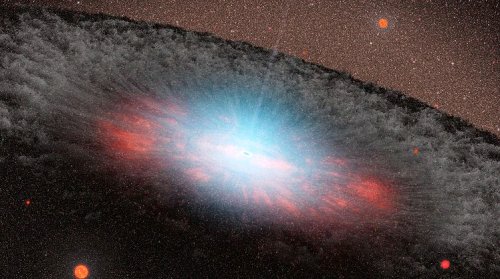
A supermassive black hole could look like this: but how did it form? (Courtesy: NASA)
By Hamish Johnston at the AAS meeting in Seattle
The universe is full of supermassive black holes (SBHs). Indeed, they make up the core of just about every galaxy. These monstrosities can be a billion times more massive than the Sun. But despite their size and ubiquity, astrophysicists don’t really understand how they are formed.
That was the topic of a fascinating talk by Mitch Begelman of the University of Colorado, who is an expert on SBH formation.
According to Begelman there are two competing theories – the small seed that takes a long time to grow, and the large seed that grows quickly.
The small seed refers to the collapse of a massive star of about 100–1000 solar masses to form a black hole that grows slowly by sucking in surrounding gas and merging with other structures until it is an SBH.
The large seed refers to the direct collapse of a huge cloud of gas to create a supermassive star that could be heavy as a billion Suns. According to Begelman, such stars would be very fragile and would only last a few million years until their cores collapsed to create a black hole.
But instead of exploding in a supernova like much smaller stars, the remaining matter would puff out to become a “quasistar” – resembling a red giant. This surrounding matter is rapidly sucked in and what remains is a black hole that Begelman believes could be as large as one million solar masses. This is around the lower limit of an SBH, and it could keep growing.
Sounds great, but is there any chance of seeing a supermassive star or quasistar?
Unlikely for supermassive stars, says Begelman, because they would be very hard to distinguish from clusters of hot stars. He is a bit more hopeful about quasistars, because they could stand out in the optical and infrared wavelengths. However, he concedes that this would be a tough job, even with the upcoming launch of the James Webb Space Telescope.
To paraphrase Begelman’s conclusion, SBH formation models are getting more sophisticated but the problem has not yet been solved.



